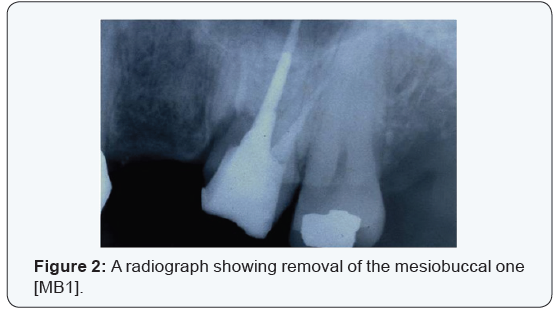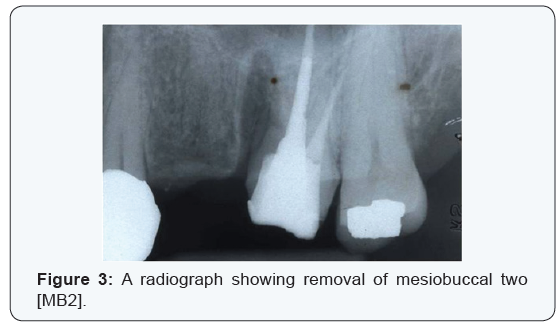Root Amputation: A Prudent Alternative to Tooth Extraction- Juniper Publishers
JUNIPER PUBLISHERS-OPEN
ACCESS JOURNAL OF DENTISTRY & ORAL HEALTH
Root Amputation: A Prudent Alternative to Tooth Extraction
Authored by Jamal Aqrabawi
Abstract
Compromised teeth often pose a significant
challenge to the clinician, complicating the treatment plan and
compromising long term prognosis. Upper molar teeth showing periodontal
attachment loss, caries or fractures involving the furcation area are
prime examples of such challenges. Treatment option for affected teeth
can be roughly divided into maintenance of the tooth through root
resection therapy, or extraction and replacement. Root resection therapy
involves removal of the diseased root along with its coronal portion
while retaining the relatively healthy parts.
The indication, contra-indications and technique
of root resection therapy are described in this case report of an upper
molar in which combined resection, endodontic and prosthetic management
resulted in a successful outcome.
Keywords: Root resection; Endodontic and prosthetic management; Oral hygiene; Mesiobuccal root amputationIntroduction
Root resection is a technique for maintaining a
portion of a diseased or injured molar by removal of one or more of its
roots [1]. In lower molars, root resection can be achieved by hemi
sectioning the whole tooth in half and removing the diseased root along
with its crown part. However, in upper molars root resection is mostly
carried out by removal of the diseased root alone (root amputation) with
rounding of the crown.
Root resection therapy outcome was investigated in a
few studies showing a variable “success rate” or survival of resected
teeth depending on the study. Langer et al. [2] showed in a randomized
retrospective study that resected molars tend to have an acceptable
success rate albeit non-lasting, with lower molars more frequently
failing due to root fracture while uppers failed due to periodontal
breakdown progression. They concluded that at least a 10 year recall
should be implemented in outcome studies to get a meaningful outcome as
failure tended to happen between the 5th or 7th year postoperatively.
About 38% of these teeth failed during the 10 year observation period
[2]. A relatively similar survival rate was reported by a different
study showing 83% survival rate at 5 years dropping to 68% at 10 year
recall time [3]. The authors concluded that the resection itself may
remove the diseased root but may also create another nidus for new
aggravating factors such as overhanging restorations [3]. On the other
hand; Carnevale et al. [4] reported a survival rate about 93% over a 10
year follow up, which was corroborated by the results reported in a more
recent study [5]. The disparity in the reported survival rates was
attributed to the technique sensitivity, case selection, patient
compliance with oral hygiene instructions and proper restorative
treatment [4].
Due to this disparity in reported outcome and
perceived high outcome or success rate of dental implants, the clinician
is often faced by the dilemma of choice between root resection therapy
and implant replacement. As one may devise, it is extremely difficult to
directly compare the two treatment modalities. Unfortunately, studies
comparing the two treatment modalities’ outcome are very few. In a
private practice retrospective study the survival rate of 701 resected
molars was compared to that of 1472 implants in molar areas after more
than 15 years of function [6]. No significant difference could be
demonstrated between the cumulative success rate of the two treatment
modalities (root resection therapy =96.8%; implants= 97%). The highest
failure rate was noted in resected molars or implants that were lone
standing (terminal abutments) [6].
As a result of the lack of more evidence, the
clinician is increasingly confronted by the pressure of choosing the
treatment modality for managing a compromised molar with furcation
involvement. Case selection for root resection therapy should take into
consideration the skills and expertise of the clinician [4,7]. The
indications and limitations of root resection therapy were discussed in a
comprehensive literature review [8] and some guidelines were suggested
in a recent review [7]. The acceptable indications of root resection
therapy from an Endodontic point of view are [1,8].
- Severe vertical root fracture involving one root.
- Undermined furcation areas due to caries, or perforations.
- Perforation of one of the roots of a molar not allowing adequate access to the original root canal hindering canal disinfection procedures.
- Failure of one of the abutments within a fixed partial denture because of periodontal disease, if the remaining abutments support is adequate.
- Inability to manage endodontic obstructions or complications in one root of a molar tooth.
While root resection therapy would be contra-indicated if
root separation is difficult due to fusion of the roots, in-operable
endodontic complication or obstruction in the root to be retained,
presence of a strong and good adjacent abutments for a bridge as
an alternative [1]. Of course, should the clinician lack the expertise
needed for proper surgical management and subsequent
restoration, root resection should not be carried out.
In this case report, an upper molar with endodontically
complicated mesiobuccal root canals was managed using root
resection therapy in a keen and compliant patient.
Case report
A 54year old female reported to my office with the chief
complaint of pain on the upper left quadrant. On clinical exam
tooth #14(UL6) has already prepared as an abutment for 3 unit
bridge, percussion test 0n #14(UL6) revealed tenderness and
discomfort.
On radiographic examination, tooth 14(UL6) has a RCT with
short fill and stripping of the mesiobuccal root (Figure 1). The
root canal on the destobuccal root and the palatal one seems to be
satisfying. Probing around tooth 14(UL6) was within normal limit.

Upon further investigation we came to conclude that the
mesiobuccal root is the source of the patient pain.
The treatment plan was presented to the patients who
include
removal of the whole mesiobuccal root (MB root amputation) and
keeping the palatal and the destobuccal roots. Upon agreement,the
treatment started by giving the patient local anesthesia. A long
shank tapered fissure diamond bur was used to make vertical cut
toward the furcation. A fine probe was passed through the cut to
ensure separation which was confirmed on the radiograph (Figure
2). The furcation area was trimmed to ensure that no spicules were
present. The mesiobuccal root was removed in 2 pieces (Figure 3).


2 months later after complete healing of the socket an impression was taken and 3 unit bridge was fabricated and since then the patient has no complaint. Five years later a radiograph was taken and showed no sign of problem (Figure 4).

Discussion
The main aim of root resection therapy is to maintain a
diseased tooth as an alternative to extraction and replacement.
Dental implants, extensive bridgework and custom-made tooth replacement can be expensive and time-consuming. Generally,
root resection and the necessary crown work are less expensive
and can be completed in 1-3 short visits.
Case selection affects the outcome of root resection as a
treatment of choice where endodontic complications affecting
one root of multi-rooted tooth. Factors such as occlusal forces,
tooth restorability, and the value of the remaining roots must
be examined before treatment [9]. Success of root resection
procedures depends significantly on proper case selection and
definite treatment plan discussed together with the endodontist,
periodontist and the restorative dentist. Unfortunately, as
mentioned earlier, a restoration can contribute to periodontal
destruction, if the margins are defective or if non-occlusal surfaces
do not have physiologic form. Also, an improper shaped occlusal
contact area may convert acceptable forces into destructive forces
and predispose the tooth trauma from occlusion and ultimate
failure of root amputation [10].
For more Open Access Journals in Juniper Publishers please
click on: https://juniperpublishers.com
For more articles in Open Access Journal of
Dentistry & Oral Health please click on:

Comments
Post a Comment